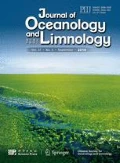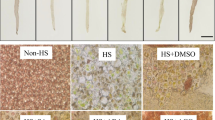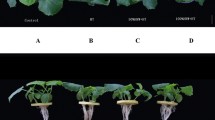Abstract
Possible mediatory roles of heat acclimation and salicylic acid in protecting the sporophyte of marine macroalga Laminaria japonica (Phaeophyceae) from heat stress were studied. Heat stress resulted in oxidative injury in the kelp blades. Under heat stress significant accumulation of hydrogen peroxide (H2O2) and malonaldehyde (MDA), a membrane lipid peroxidation product, and a drastic decrease in chlorophyll a content were recorded. Activity of the enzymatic antioxidant system was drastically affected by heat stress. The activity of superoxide dismutase (SOD) was significantly increased while peroxidase (POD), catalase (CAT) and glutathione peroxidase (GPX) were greatly inhibited and, simultaneously, phenylalanine ammonia-lyase was activated while polyphenol oxidase (PPO) was inhibited. Both heat acclimation pretreatment and exogenous application of salicylic acid alleviated oxidative damage in kelp blades. Blades receiving heat acclimation pretreatment and exogenous salicylic acid prior to heat stress exhibited a reduced increase in H2O2 and MDA content, and a lower reduction in chlorophyll a content. Pretreatment with heat acclimation and salicylic acid elevated activities of SOD, POD, CAT, GPX and PPO. Considering these results collectively, we speculate that the inhibition of antioxidant enzymes is a possible cause of the heat-stress-induced oxidative stress in L. japonica, and enhanced thermotolerance may be associated, at least in part, with the elevated activity of the enzymatic antioxidant system.
Similar content being viewed by others
References
Aebi H. 1984. Catalase in vitro. Methods Enzymol., 105: 121–126.
Bradford M M. 1976. A rapid and sensitive method for the quantitation of microgram quantities of protein utilizing the principle of protein-dye binding. Anal. Biochem., 72: 248–254.
Dat J F, Foyer C H, Scott I M. 1998. Changes in salicylic acid and antioxidants during induction of thermotolerance in mustard seedlings. Plant Physiol., 118: 1 455–1 461.
Evans J J. 1965. The distribution of peroxide in extreme dwarfs and normal tomato. Phytochemistry., 4: 499–503.
Gong M, Li Y J, Dai X, Tian M, Li Z G. 1997. Involvement of calcium and calmodulin in the acquisition of heat-shock-induced thermotolerance in maize seedlings. J. Plant Physiol., 150: 615–621.
Grace S C, Logan B A, Adams W W III. 1998. Seasonal differences in foliar content of chlorogenic acid, a phenylpropanoid antioxidant, in Mahonia repens. Plant Cell Environ., 21: 513–521.
He Y L, Liu Y L, Chen Q, Bian A H. 2002. Thermotolerance related to antioxidation induced by salicylic acid and heat hardening in tall fescue seedlings. J. Plant Physiol. Mol. Biol., 28: 89–95.
Heath R L, Packer L. 1968. Photoperoxidation in isolated chloroplasts. I. Kinetics and stoichiometry of fatty acid peroxidation. Arch. Biochem. Biophys., 125: 189–198.
Janda T, Szalai G, Rios-Gonzales K, Veisa O, Paldi E. 2003. Comparative study of frost tolerance and antioxidant activity in cereals. Plant Sci., 164: 301–306.
Jensen A. 1978. Chlorophylls and carotenoids. In: Hellebust J A, Craigie J S eds. Handbook of phycological methods. Cambridge University Press. UK. p. 59–71.
Jiang Y, Huang B. 2001. Drought and heat stress injury to two cool-season turfgrass in relation to antioxidant metabolism and lipid peroxidation. Crop Sci., 41: 436–442.
Larkindale J, Huang B. 2004. Thermotolerance and antioxidant systems in Agrostis stolonifera: involvement of salicylic acid, abscisic acid, calcium, hydrogen peroxide, and ethylene. J. Plant Physiol., 161: 405–413.
Larkindale J, Knight M R. 2002. Protection against heat stress-induced oxidative damage in Arabidopsis involves calcium, abscisic acid, ethylene and salicylic acid. Plant Physiol., 128: 682–695.
Lawrence R A, Burk R F. 1976. Glutathione peroxidase activity in selenium-deficient rat liver. Biochem. Biophys. Res. Commun., 71: 952–958.
Liu H T, Huang W D, Pan Q H, Weng F H, Zhan J C, Liu Y, Wan S B, Liu Y Y. 2006. Contributions of PIP2-specific-phospholipase C and free salicylic acid to heat acclimation-induced thermotolerance in pea leaves. J. Plant Physiol., 163: 405–416.
Liu X, Huang B. 2000. Heat stress injury in relation to membrane lipid peroxidation in creeping bentgrass. Crop Sci., 40: 503–513.
Lüning K, Pang S J. 2003. Mass cultivation of seaweeds: current aspects and approaches. J. Appl. Phycol., 15: 115–119.
McCord J M, Fridovich I. 1969. Superoxide dismutase: an enzymic function for erythrocuprein (hemocuprein). J. Biol. Chem., 244: 6 049–6 055.
Mukherjee S P, Choudhuri M A. 1983. Implication of water stress-induced changes in the levels of endogenous ascorbic acid and hydrogen peroxide in Vigna seedlings. Physiol. Plant., 58: 166–170.
Rivero R M, Ruiz J M, García P C, López-Lefebre L R, Sánchez E, Romero L. 2001. Resistance to cold and heat stress: accumulation of phenolic compounds in tomato and watermelon plants. Plant Sci., 160: 315–321.
Sangwan V, Örvar B L, Beyerly J, Hirt H, Dhindsa R S. 2002. Opposite changes in membrane fluidity mimic cold and heat stress activation of distinct plant MAP kinase pathways. Plant J., 31: 629–638.
Sun W, Montagu M V, Verbruggen N. 2002. Small heat shock proteins and stress tolerance in plants. Biochim. Biophys. Acta., 1 577: 1–9.
Uchida T, Toda S, Matsuyama Y, Yamaguchi M, Kotani Y, Honjo T. 1999. Interaction between the red tide dinoflagellates Heterocapsa circularisquama and Gymnodinium mikimotoi in laboratory culture. J. Exp. Mar. Biol. Ecol., 241: 285–299.
Wahid A, Gelani S, Ashraf M, Foolad M R. 2007. Heat tolerance in plants: An overview. Environ. Exp. Bot., 61: 199–223.
Wang L J, Li S L. 2006. Salicylic acid-induced heat or cold tolerance in relation to Ca2+ homeostasis and antioxidant systems in young grape plants. Plant Sci., 170: 685–694.
Wu Z F, Chen L F, Zhang Y S, Xu Y G, Wang Y Z. 1997. Extraction and partial characterization of bioactive substance from Hyphal cell wall of Fusarium graminearum Schw. J. Agric. Biotechnol., 5: 168–172.
Xu S, Li J, Zhang X, Wei H, Cui L. 2006. Effects of heat acclimation pretreatment on changes of membrane lipid peroxidation, antioxidant metabolites, and ultrastructure of chloroplasts in two cool-season turfgrass species under heat stress. Environ. Exp. Bot., 56: 274–285.
Zauberman G, Ronen R, Akerman M, Weksler A, Rot I, Fuchs Y. 1991. Postharvest retention of the red colour of litchi fruit pericarp. Sci. Hortic., 47: 89–97.
Author information
Authors and Affiliations
Corresponding author
Additional information
Supported by the Open Funds of the Key Oceanic Science and Engineering Laboratory of National Bureau of Oceanography (MESE-2008-01); and the Specialized Research Program for Marine Public Welfare Industry, SOA (No. 200805066)
Rights and permissions
About this article
Cite this article
Zhou, B., Tang, X. & Wang, Y. Salicylic acid and heat acclimation pretreatment protects Laminaria japonica sporophyte (Phaeophyceae) from heat stress. Chin. J. Ocean. Limnol. 28, 924–932 (2010). https://doi.org/10.1007/s00343-010-9049-7
Received:
Accepted:
Published:
Issue Date:
DOI: https://doi.org/10.1007/s00343-010-9049-7




